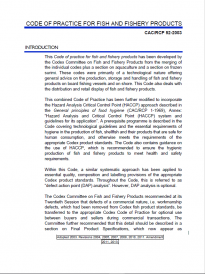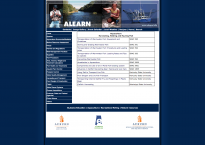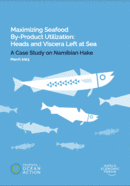Application of Appropriate Technology for Handling After Harvest
Key technology affecting food loss and waste (FLW) includes the harvesting, handling, storage, and holding equipment. Although technology will vary according to the volume of fish, species, production method and whether the fish or shellfish are to be marketed live or dead, the following describes some of the key technology solutions to FLW reduction.
Harvesting
Harvesting
There are several considerations prior to harvesting. Fish must be in good health and good condition before they are harvested, particularly if they are to be marked live. Fish in poor condition, for example, may die during post-harvest transport.
Another key pre-harvest issue which influences FLW after harvest is whether or not fish have been starved prior to harvesting. It is important to withhold food from fish for at least 1 to 3 days before harvest and or live transport, and potentially longer depending on the species. Fish with empty stomachs are hardier, will not regurgitate food in the transport unit, and will produce less metabolic waste.
Several methods can be used to harvest fish efficiently and safely, but careful planning is required for a successful harvesting operation. Harvesting logistics should always be considered in the design and construction of aquaculture facilities e.g. pond design and location of cages. Although, no immediate signs of FLW may be seen during and immediately after harvesting, what happens during harvesting can have an impact on quality and mortality of live fish further down the value chain.
Ponds
Ponds
Harvesting pond raised fish can be the most labour intensive aquaculture activity. Ponds are typically harvested by the drain-and-seine (total) or the multiple (partial) harvest method. To reduce FLW associated with harvesting ponds:
- harvesting should take place during cool periods (e.g. early morning hours)
- nets must have the proper mesh size and net material to avoid injuring or gilling fish
- pond should be clear of debris prior to harvest
- harvest as quickly as possible without delays
- have adequate labour available to ensure the process is quick
- use a bag woven into a seine net, as it provides a good area to capture, hold and harvest fish
- land the seine near a water supply or aerator where fresh, oxygenated water can be provided if needed. When fish are crowded, they can rapidly deplete the dissolved oxygen in a localized area, especially in warm weather
- once ponds have been harvested, it is essential that fish get to their destination as soon as possible. If fish are to be held for more than a few minutes, they should be moved to deeper water and held in a live-car (net sock attached to the seine) or cage. It is helpful to circulate cool high quality clean water around a cage or live-car
- if in doubt, contract harvesting out to a specialist provider
Cages
Cages
One of the advantages of cage culture is that it is possible to partially harvest fish from cages as needed. The fish are crowded in pens using sweep nets and are either pumped from the holding pen alive and transported to the slaughter plant, generally by well boat, or slaughtered on the side of the pens. Fish handling and harvesting are more straightforward compared to pond harvesting. To reduce FLW associated with cages:
- harvest should take place during cool periods (e.g. early morning hours)
- use nets of the proper mesh size and material to avoid injuring or gilling fish
- harvest as quickly as possible without delays
- have adequate labour available to ensure the process is quick
Fish Pumps
Fish Pumps
Fish pumps enable the swift removal of fish or shrimp from pond, cage or pen during harvesting. Pump technology makes harvesting and handling easier and quicker, thereby assisting in the reduction of FLW. Various models of pump are available, and are used to transfer live fish to holding tanks for transport and for fish that will be slaughtered immediately after harvest.
Live Storage and Transport
Live Storage and Transport
Live fish marketing is popular for many species in many parts of the world.
To minimize FLW, especially mortality of live fish, the following are some good practices:
- After fish are harvested, carefully remove debris and give fish a resting period of several hours before they are handled again
- Slowly acclimatize the fish to the expected transport water temperature and avoid temperature shock
- Chronic fish losses or weak fish problems are often associated with handling and transporting fish in water of inadequate hardness. Ensure the water used has the right hardness and apply any allowed chemicals to the water according to legislation and best practice
- Carbon dioxide will accumulate in water during holding and transport, but high oxygen levels, air circulation and water agitation will help reduce any adverse effects
- Starving fish before transport, using clean water and lowering the water temperature all help reduce harmful ammonia build up
- Load fish carefully into transport units
- Increase the oxygen supply while fish are being loaded
- Regularly check dissolved oxygen (DO) in water to assure adequate concentrations. An oxygen meter or test kit is important for measuring oxygen concentrations in transport and receiving waters. Oxygen levels and water temperature can be monitored easily by using an oxygen meter
- A variety of methods can aerate water. Because fish are densely crowded and excited especially after loading, it is essential to have an aeration system that provides adequate dissolved oxygen (DO) rapidly and efficiently. For most cases, maintain oxygen concentrations above 6 parts per million (ppm) at all times.
- Electric agitators or air blowers are commonly used to enhance carbon dioxide removal and aerate live fish transport tanks. While these devices are practical and readily available, they can have some disadvantages: high initial investment, possible equipment or power failure, and may cause water temperature to rise more rapidly during transport. An alternative is the use of pure oxygen gas. There are several advantages with this method: equipment can be leased; there is little chance of equipment failure; it may reduce water temperature slightly; water turbulence is limited; and loading rates can be increased by 25%.
Stunning and Bleeding
Stunning and Bleeding
Stunning, killing and bleeding of certain species are handling operations that are essential in order to establish a high quality end product and hence reduce FLW associated with quality deterioration.
A stunned fish is motionless and this facilitates further processing. Electricity is commonly used to stun fish after harvest. Proper stunning results in immediate unconsciousness and insensibility to pain. The period of insensibility is dependent on a number of parameters including, but not limited to: species, size, stress levels, temperature, number of fish, and duration of stunning.
Bleeding is usually carried out by cutting the gill arches rapidly and immersing the fish in iced water. Inadequate bleeding leads to blood spots in the fillets and flesh. Immediate bleeding of live fish (or no later than 30 min post-mortem) can eradicate this problem in some species. Fish are then typically gutted, washed, chilled, and ready for market.
Fresh Fish Storage
Fresh Fish Storage
Chilling using ice is key post-harvest FLW control. For the full benefits of chilling to be realized, it is essential to maintain chill temperatures throughout different fish-handling operations, starting immediately after the fish are harvested from the pond or cage. The time between the harvest and/or death of the fish to when they are properly iced must be as short as possible, with minimum exposure to high temperatures. Good chilling practice includes:
- maintain a 1kg fish to 1kg ice ratio
- ice should be made from drinking quality (potable) water
- store ice in clean boxes or bags
- procure ice from a government-approved provider
- if water is mixed with ice, make sure only clean water is used
- use clean, well made insulated boxes
- place a layer of ice on the bottom of the box and then layers of fish and ice
There are different types of ice, for example: block, plate, tube and flake. Block ice stores well but requires proper crushing before use. Other types of ice have good chilling properties. Ice in itself is no guarantee of a better product unless proper handling procedures are fully implemented before the fish are actually iced.
Key Publications
Code of Practice for Fish and Fishery Products CAC/RCP 52-2003 Global standard that presents information on freezing and cold storage practices which aim to reduce spoilage and waste. | |
Extension information on various good harvesting and post-harvesting handling practices for aquaculture. | |
Harvest is one of the most important aspects of aquaculture but is often under-equipped and poorly planned. Harvest may be as simple as partial draining but can also be the most labour intensive activity. |
More Resources
More Resources
31 October 2023
05 September 2023














